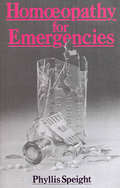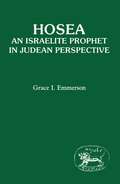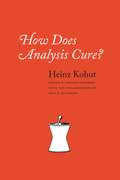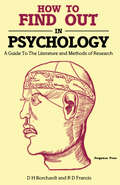- Table View
- List View
HOAI-Praxis bei Ingenieurleistungen: Anleitung zur Anwendung der Honorarordnung für Architekten und Ingenieure
by Martin RusamDieser ganz auf die Bedürfnisse der Praxis zugeschnittene Leitfaden konzentriert sich auf die ingenieurspezifischen Leistungen. Präzise Erläuterungen, ergänzt durch Berechnungsbeispiele, helfen bei der korrekten Honorarermittlung und -abrechnung.
Holzkunde: Band 2 Zur Biologie, Physik und Chemie des Holzes (Lehrbücher und Monographien aus dem Gebiete der exakten Wissenschaften #19)
by H.H. BosshardHolzkunde: Aspekte der Holzbearbeitung und Holzverwertung (Lehrbücher und Monographien aus dem Gebiete der exakten Wissenschaften #20)
by H.H. BosshardHome Environment and Early Cognitive Development: Longitudinal Research
by Allen W. GottfriedHome Environment and Early Cognitive Development: Longitudinal Research presents the results of longitudinal studies in Canada and the United States that looked into the relationship between home environment and early cognitive development. The aim of these investigations is to determine the specific or process home environmental variables that correlate with and possibly regulate cognitive development during infancy and the preschool years. Comprised of 10 chapters, this book begins with a brief introduction to the issues investigated. Each of the following seven chapters is devoted to a longitudinal investigation, with emphasis on data presentation, analysis, and interpretation. The influence of home environment on cognitive development in young children of middle-socioeconomic-status families as well as Mexican-American children is considered. Assessments of cognitive development are carried out using standard psychometric tests of intelligence; Piagetian-type measures of sensorimotor development; measures of language development; and measures of recognition memory for infants. The final chapter assesses the implications for intervention of the link between home environment and early cognitive development.This monograph will be of interest to psychologists and sociologists.
Homoeopathy For Emergencies
by Phyllis SpeightThis small book has been written to enable those with no knowledge of homoeopathy to apply the remedies in emergencies and injuries.These are safe and have no side effects and if well chosen to match the patient's symptoms they can produce amazing results.The emergencies are listed in alphabetical order and I have tried to include anything that can develop quickly and needs prompt attention. In some cases a doctor should be called but, even so, help may be given pending his arrival.
Hormonal Control of the Hypothalamo-Pituitary-Gonadal Axis (Biochemical Endocrinology)
by Kenneth W. McKernsThe eleventh monograph and meeting of the Foundation on "Hormon al Control of the Hypothalamo-Pituitary-Gonadal Axis" was held in October 1983 at the Weizmann Institute of Science. This monograph honors the memory of Professor Hans R. Lindner, a productive and innovative scientist greatly respected and admired by his col leagues. When addressing the opening session I remarked that my impres sion of the Weizmann Institute was one or two large buildings hous ing the various departments. This was my first visit to Israel and I was overwhelmed by the beautiful semi-tropical gardens of the in stitute, in a setting of shrubs and trees, orange groves and flow ers. Sited among this seventy-five acres are over fifty buildings and residential areas for the staff and visiting scientists. I saw pictures of this area when Dr. Chaim Weizmann founded in 1934, the Daniel Sieff Research Institute, the forerunner of the Weizmann In stitute. The site was sand dunes without a blade of grass. That the desert shall bloom is illustrative of the progress made in Is rael. The topics of the monograph are grouped into twelve sections.
Hormonal Regulation of Development II: The Functions of Hormones from the Level of the Cell to the Whole Plant (Encyclopedia of Plant Physiology #10)
by M. L. Evans W. P. Jacobs H. Kaldewey A. C. Leopold A. G. Matthysse A. W. Naylor L. D. Nooden J. A. Romberger T. K. Scott T. J. Wodzicki S. ZajaczkowskiThis is the second of the set of three volumes in the Encyclopedia of Plant Physiology, New Series, that will cover the area of the hormonal regulation of plant growth and development. The overall plan for the set assumes that this area of plant physiology is sufficiently mature for a review of current knowl edge to be organized in terms of unifying principles and processes. Reviews in the past have generally treated each class of hormone individually, but this set of volumes is subdivided according to the properties common to all classes. Such an organization permits the examination of the hypothesis that differing classes of hormones, acting according to common principles, are determinants of processes and phases in plant development. Also in keeping with this theme, a plant hormone is defined as a compound with the properties held in common by the native members of the recognized classes of hormone. Current knowledge of the hormonal regulation of plant development is grouped so that the three volumes consider advancing levels of organizational complexity, viz: molecular and subcellular; cells, tissues, organs, and the plant as an organized whole; and the plant in relation to its environment.
Hormonale Störungen in der Gynäkologie: Diagnostik und Behandlung (Kliniktaschenbücher)
by P. J. KellerHorticultural Reviews (Horticultural Reviews #93)
by Jules JanickHorticultural Reviews presents state-of-the-art reviews on topics in horticultural science and technology covering both basic and applied research. Topics covered include the horticulture of fruits, vegetables, nut crops, and ornamentals. These review articles, written by world authorities, bridge the gap between the specialized researcher and the broader community of horticultural scientists and teachers.
Horticultural Reviews (Horticultural Reviews #95)
by Jules JanickHorticultural Reviews presents state-of-the-art reviews on topics in horticultural science and technology covering both basic and applied research. Topics covered include the horticulture of fruits, vegetables, nut crops, and ornamentals. These review articles, written by world authorities, bridge the gap between the specialized researcher and the broader community of horticultural scientists and teachers.
Hosea: An Israelite Prophet in Judean Perspective (The Library of Hebrew Bible/Old Testament Studies)
by Grace I. EmmersonThe book of Hosea lends itself well to a study of the interplay of traditions and an analysis of the modes of thought that belong to the northern and southern kingdoms. While its origin lies in the northern kingdom, its transmission has been largely in Judah. The history of the transfer of material is not one of uninterrupted continuity and, in tracing this, Emmerson seeks to provide an overview of the specifically Judean influences which can be traced in the book of Hosea, and thus better identify and examine the relationship of northern and southern traditions.
Housing and Urban Development in the USSR (Studies in Soviet History and Society)
by Gregory D. AndruszHousing and Urban Development in the USSR (Studies in Soviet History and Society)
by Gregory D. AndruszHow Does Analysis Cure?
by Heinz KohutThe Austro-American psychoanalyst Heinz Kohut was one of the foremost leaders in his field and developed the school of self-psychology, which sets aside the Freudian explanations for behavior and looks instead at self/object relationships and empathy in order to shed light on human behavior. In How Does Analysis Cure? Kohut presents the theoretical framework for self-psychology, and carefully lays out how the self develops over the course of time. Kohut also specifically defines healthy and unhealthy cases of Oedipal complexes and narcissism, while investigating the nature of analysis itself as treatment for pathologies. This in-depth examination of “the talking cure” explores the lesser studied phenomena of psychoanalysis, including when it is beneficial for analyses to be left unfinished, and the changing definition of “normal.” An important work for working psychoanalysts, this book is important not only for psychologists, but also for anyone interested in the complex inner workings of the human psyche.
How Does Analysis Cure?
by Heinz KohutThe Austro-American psychoanalyst Heinz Kohut was one of the foremost leaders in his field and developed the school of self-psychology, which sets aside the Freudian explanations for behavior and looks instead at self/object relationships and empathy in order to shed light on human behavior. In How Does Analysis Cure? Kohut presents the theoretical framework for self-psychology, and carefully lays out how the self develops over the course of time. Kohut also specifically defines healthy and unhealthy cases of Oedipal complexes and narcissism, while investigating the nature of analysis itself as treatment for pathologies. This in-depth examination of “the talking cure” explores the lesser studied phenomena of psychoanalysis, including when it is beneficial for analyses to be left unfinished, and the changing definition of “normal.” An important work for working psychoanalysts, this book is important not only for psychologists, but also for anyone interested in the complex inner workings of the human psyche.
How Does Analysis Cure?
by Heinz KohutThe Austro-American psychoanalyst Heinz Kohut was one of the foremost leaders in his field and developed the school of self-psychology, which sets aside the Freudian explanations for behavior and looks instead at self/object relationships and empathy in order to shed light on human behavior. In How Does Analysis Cure? Kohut presents the theoretical framework for self-psychology, and carefully lays out how the self develops over the course of time. Kohut also specifically defines healthy and unhealthy cases of Oedipal complexes and narcissism, while investigating the nature of analysis itself as treatment for pathologies. This in-depth examination of “the talking cure” explores the lesser studied phenomena of psychoanalysis, including when it is beneficial for analyses to be left unfinished, and the changing definition of “normal.” An important work for working psychoanalysts, this book is important not only for psychologists, but also for anyone interested in the complex inner workings of the human psyche.
How Does Analysis Cure?
by Heinz KohutThe Austro-American psychoanalyst Heinz Kohut was one of the foremost leaders in his field and developed the school of self-psychology, which sets aside the Freudian explanations for behavior and looks instead at self/object relationships and empathy in order to shed light on human behavior. In How Does Analysis Cure? Kohut presents the theoretical framework for self-psychology, and carefully lays out how the self develops over the course of time. Kohut also specifically defines healthy and unhealthy cases of Oedipal complexes and narcissism, while investigating the nature of analysis itself as treatment for pathologies. This in-depth examination of “the talking cure” explores the lesser studied phenomena of psychoanalysis, including when it is beneficial for analyses to be left unfinished, and the changing definition of “normal.” An important work for working psychoanalysts, this book is important not only for psychologists, but also for anyone interested in the complex inner workings of the human psyche.
How Does Analysis Cure?
by Heinz KohutThe Austro-American psychoanalyst Heinz Kohut was one of the foremost leaders in his field and developed the school of self-psychology, which sets aside the Freudian explanations for behavior and looks instead at self/object relationships and empathy in order to shed light on human behavior. In How Does Analysis Cure? Kohut presents the theoretical framework for self-psychology, and carefully lays out how the self develops over the course of time. Kohut also specifically defines healthy and unhealthy cases of Oedipal complexes and narcissism, while investigating the nature of analysis itself as treatment for pathologies. This in-depth examination of “the talking cure” explores the lesser studied phenomena of psychoanalysis, including when it is beneficial for analyses to be left unfinished, and the changing definition of “normal.” An important work for working psychoanalysts, this book is important not only for psychologists, but also for anyone interested in the complex inner workings of the human psyche.
How Does Analysis Cure?
by Heinz KohutThe Austro-American psychoanalyst Heinz Kohut was one of the foremost leaders in his field and developed the school of self-psychology, which sets aside the Freudian explanations for behavior and looks instead at self/object relationships and empathy in order to shed light on human behavior. In How Does Analysis Cure? Kohut presents the theoretical framework for self-psychology, and carefully lays out how the self develops over the course of time. Kohut also specifically defines healthy and unhealthy cases of Oedipal complexes and narcissism, while investigating the nature of analysis itself as treatment for pathologies. This in-depth examination of “the talking cure” explores the lesser studied phenomena of psychoanalysis, including when it is beneficial for analyses to be left unfinished, and the changing definition of “normal.” An important work for working psychoanalysts, this book is important not only for psychologists, but also for anyone interested in the complex inner workings of the human psyche.
How to Find Out in Psychology: A Guide to the Literature and Methods of Research
by D. H. Borchardt R. D. FrancisHow to Find Out in Psychology: A Guide to the Literature and Methods of Research is a research guidebook in psychology. The book is comprised of 11 chapters that address concerns in psychological research. The text first covers the concept of psychology and its major theories, and then proceeds to tackling bibliographic aids for research in psychology. The next series of chapters details the methodologies in researching and presenting. The last chapters discuss the professional matters in psychology. The book will be of great use to students, researchers, and practitioners of behavioral science.


















